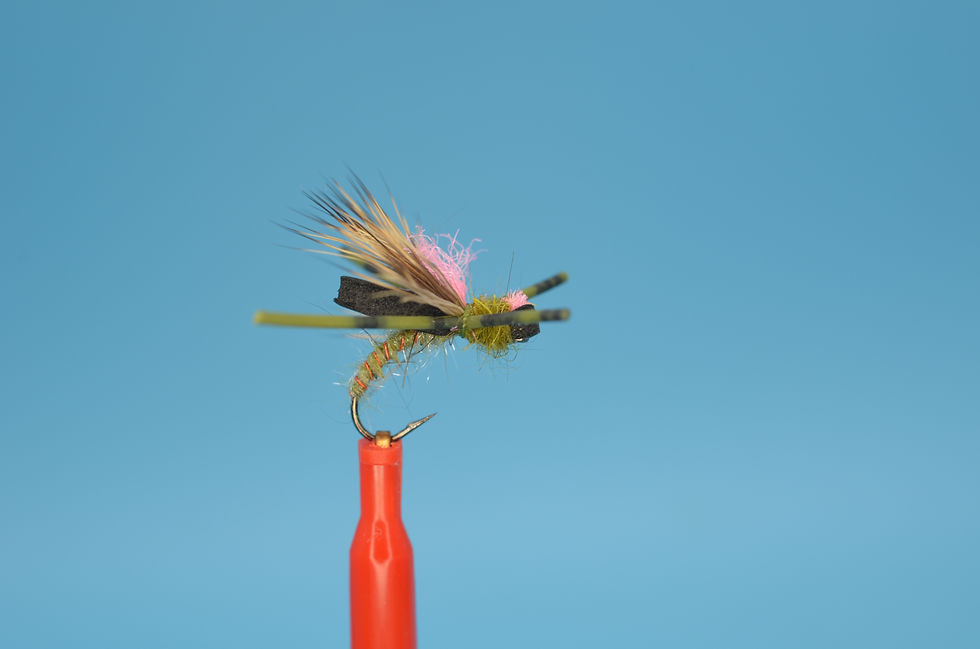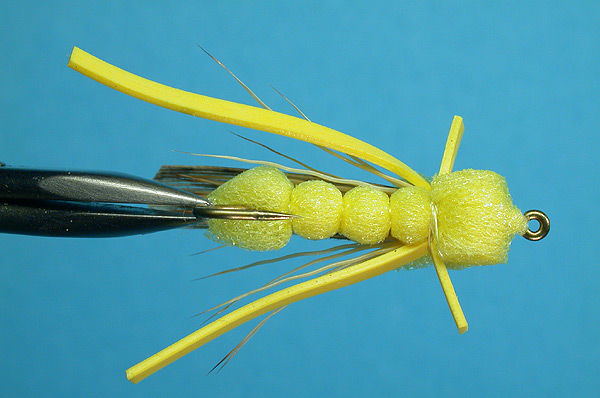This is not how it usually works in fly fishing and fly tying where fly creators keep their new flies close to the vest until they get them to a point where they are ready to be sold to Umpqua or one of the other producers that give them royalties. Make no mistake, I am not saying this fly is worthy of anything like that. It was my attempt at figuring out how to tie a summer / fall terrestrial for once the fish have become a bit more educated and picky.

In my mind, a good, new, fly pattern is one that solves a problem - and is not just another variation on a theme. As I wrote about recently, it is not easy to come up with a truly new fly pattern as we are limited by materials, our imaginations, and that hook that materials and our imaginations must be applied to. The idea was to tie a subtle, lower floating terrestrial - one that would get sipped rather than smashed. I do a lot of terrestrial fishing in summer and early fall, it is really some of the most fun you can have with a fly rod in hand. Over time, I found that there are times that the standard terrestrials become a little less effective and trout seem wary of high floating terrestrials like the Morrish Hopper, one of my summer standards.

The Morrish Hopper is a great terrestrial fly pattern and one of my favorites both to tie and to fish. The Morrish Hopper ticks off a lot of the boxes I think are important in a fly pattern. Its profile is very accurate, it floats well, the foam indicator helps make it quite visible, it has some movement built into it and it is easily moved, and it is relatively quick and easy to tie so I do not mind losing a fly here and there. There are a ton of options for grasshopper fly patterns and the Morrish is a great option for a higher floating fly. Lower floating options - such as many of the patterns that utilize deer hair rather than foam - exist for when fish do not seem to be "on" the higher floating Morrish Hopper. A few suggestions are the simple but overlooked Letort Hopper, Dave's Hopper, Whit Hopper, Joe's Hopper, and a few hundred other hopper variations.

Do we really need another hopper fly pattern? No, probably not but I would suggest that this not just a hopper pattern but a more general purpose terrestrial akin to Andrew Grillo's Hippie Stomper. Like most any fly pattern, it borrows heavily from existing patterns. It is hopper-ish but a rather smaller and thinner hopper. It is ant-ish - and that is probably what it most looks like. And it can be beetle-ish, particularly a "spent beetle". I honestly do not know what exactly fish take it for, which as I recently wrote, I think is largely a fool's errand. In testing and adjusting the pattern for the last few summers, it works at times when other flies do not seem to do as well. That said, there is nothing all that "magical" about it and
First, let me give you what I was shooting for and the inspiration for those choices.
I wanted to get the abdomen into the water to make it a little more visible and more vulnerable looking. A number ant patterns in particular try to do this too. The Poodle is an ant pattern and a favorite of my friend Ben and part of where the idea comes from. There are some hints of that in this fly, most notably, the Klinkhammer hook.
X-legs in the name come from the prominent legs which I think are an important trigger. The Hippie Stomper and "my cricket" (pattern is in My Driftless Baker's Dozen) have similar X-legs and are two of my favorite terrestrial patterns.
Visibility - low floating flies can be notoriously hard to spot on the water. Improved visibility is the reason that "my cricket", which is basically a modification of the Wendelberg cricket, works so well and I think so much better than the standard pattern or a simple Letort cricket - that and the addition of rubber legs.
There are lots of other fly pattern ideas in the fly but it is largely a modified, lower floating Hippie Stomper.

Crowdsourcing a Fly Pattern
As mentioned, I have fished the pattern - and a ton of variations - over the past few years. I have shared a few with friends and have put a few in fly boxes I have donated to Trout Unlimited fundraisers. First, the fly pattern...
The General Pattern
Hook: Klinkhammer hook (#10 to #18)
Thread: Yep, use some
Rib: Copper wire or Krystal Flash
Abdomen: Natural/synthetic coarse dubbing like HareTron or Squirrel with SLF
Underwing: Deer Hair
Overwing: Foam or synthetic as indicator
Legs: Rubber of your choice
Hackle: If you want, I tie them both with and without hackle but I clip the bottom of the fly.

Variations on the pattern that I have tried are quite numerous but all are in keeping with the general theme - a Klinkhammer hook to sink the abdomen, rubber legs that stick out to the front and back, and a highly visible element. Again, the idea was to try to solve a problem - fish will get educated and seem to sip it more readily than they will smack a higher floating Morrish (or other) hopper pattern.

Strengths: It floats low, it is visible, the hook-up rates are very good, it seems to work when fishing gets tough. And it is relatively quick and easy to tie, something I value in a fly.
Weaknesses: It floats low - often a good thing but not always. Foam wings can cause a lot of tippet twisting which I have not fully worked out what factors lead to more and less twisting (to be fair, the Hippie Stomper is a pretty good tippet twister too). I think that the hackle can also help contribute to the twisting.

This is not my first time trying to create a new terrestrial fly pattern. Many - and I do mean many - years ago, well before foam hopper became ubiquitous, I created the West Fork Hopper. It is now quite ordinary but at the time, it was somewhat new and novel. And it worked - well, sort of. If there was an issue, it was that hook-up rates for a foam fly with foam on the underside of the hook are not great. But it was fun - and the first ever cast, right in the West Fork Sports Club grounds landed an 18 inch Brown Trout.

Now the crowdsourcing...The fly pattern (concept?) is nothing terribly new and novel and it is certainly not a "magical" fly but I have had some success with it in July and August, in particular, when little else was working. And I would find that trout would come out from cover and slowly sip in this fly. Tim Landwehr (links to a podcast) at Tight Lines Fly Shop talks about this with "Mr. Wiggly" style flies and how they are taken slowly and confidently by Smallmouth Bass. This pattern seems to get taken in the same way - more like how trout tend to eat ants than how they tend to smash hoppers. It is one of my first choices for middle-of-the-day fishing in the summer and early fall. I probably start with a Morrish Hopper or a Hippie Stomper but if they are not working, this fly is generally a good change of pace that often (but not always) works.
I think a lot of fly tying is - or should be - about experimenting and trying new and different things and figuring out what works, and what does not work. Dr. J's X-Legs (for lack of a better name) is a platform to play around with. There are so many different ways to meet my objectives - a low-floating, highly-visible generalist terrestrial pattern. Give it a try, play around with it a bit and let me know what you find. I will keep at it and have some ideas for something a little closer to The Poodle to be a little more "ant-ish", and maybe tie it in smaller sizes. I would say I tie and fish it in #12 and #14 most of the time (but Klinkhammer hooks are long shanked). I started with the foam winged versions and still use them but I have not really worked out the tippet twisting issues. Play around with colors - I have fished it in a number of colors and have not really found any patterns (but my bias is that color rarely matters). Maybe knot the back legs in a more hopper or cricket-like version. Maybe come up with some variations I have not thought of.
So play around a little bit and see what works best for you - but please let us all know what works and what does not - for you.

Soon link after, I learned that Hamm was so taken with the Sub that he'd wear it whether or not the cameras were rolling. Eventually, filming wrapped and the watch made it back to me. Now, it wasn't my personal watch or anything, but I must say it was neat to link see it again and feel how it had changed, spiritually speaking. When I sent it off it was but a normal 1680. But when I got it back it had a certain link star quality to it.